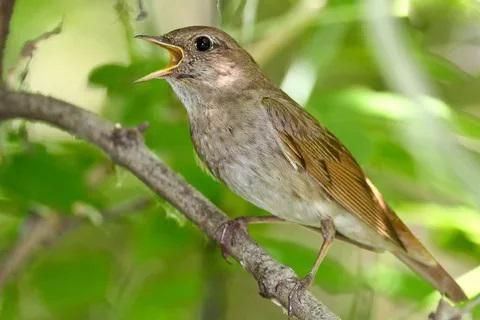It's a member of the chats family of species, which includes other species that live on the ground. The nightingale has brown upper parts with a reddish tail and a buff-to-white underside.
Both sexes have a similar physical appearance. Described as one of nature's most beautiful sounds, this bird's song has been used in songs, fairy tales, opera, and even poetry.
Personal Habits and Way of Life
In the daytime, the nightingale is a lone bird. They are quite timid and prefer to remain hidden in dense vegetation. Hopping about on the ground, these birds look for food in the leaf litter or pick through the foliage on low branches and leaves.
It is possible that they will catch their meal on the ground or fly after insects as they hunt from perches and drop-offs. While nightingales are most often heard singing at night, they can sometimes be heard singing during the day.
They have a wide range of whistles, trills, and gurgles in their song, which is rather loud. Males who have not yet found a partner are the only ones that sing at night. Birds are said to use morning songs as a means of protecting their territory before daybreak.
Due to increased background noise, nightingales sing even louder in cities and towns. Whistling crescendos are the most distinctive quality of their music. An alarm call is made by nightingales when they sense danger or distress.
Nutrition and Diet
Carnivores (insect eaters) and herbivores form the nightingale family (frugivores, granivores). Beetles, gnats, caterpillars, flies, tiny spiders, and larvae are all prey for them. Berries and seeds are added to the diet of these birds in the fall.
Mating Habits and Practices
Even though nightingales are serially monogamous, the breeding season is the only time they couple up. They breed throughout Europe from the end of April until the middle of July. In the mating season, nightingales become extremely protective of their nests.
They build their nests in thick foliage, either directly on the ground or quite close to it. The nest is built of grass and decaying leaves and has an open cup shape.
Within 13 to 14 days of fertilization, the female produces 4-5 olive-green eggs, which the male feeds while she incubates.
Chicks are helpless when they are hatched and are nourished by their parents for 10 to 12 days until they are ready to fly out from the nest. After 15 to 30 days of independent living, they are ready to reproduce and are able to lay eggs after a year.
Ecological Niche
To their environment, nightingales are crucial. Birds that feed on insects that can harm trees and shrubs are responsible for keeping populations of these pests in check.
Conclusion
The nightingale gets its name from the fact that it sings a lot at night. In its Old English form "night songstress" nihtegale, the word has been used for more than a thousand years.
The word "night" appears in its name because of this. For many years, authors thought that only women sang, although this has now been proven to be incorrect.
Nightingales are notoriously difficult to observe due to their shy nature, and most people have only heard of them.






















 sunrise
StableDiffusion
sunrise
StableDiffusion
 bonfire friends
StableDiffusion
bonfire friends
StableDiffusion
 sadness
StableDiffusion
sadness
StableDiffusion

 purple skies
StableDiffusion
purple skies
StableDiffusion





